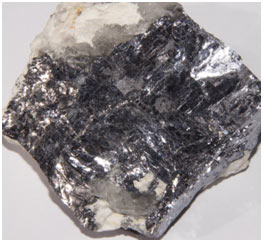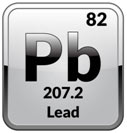Introduction
-
- Lead is a metal located in group number 14 of the periodic table.
- The atomic number of lead is 82 whereas its atomic mass is 207.2.
- A single atom of lead contains 82 electrons.
- It has 82 protons and 126 neutrons in its nucleus.
- The scientific name of lead is “Plumbum” and it is represented by the symbol “Pb”.
Naming and History of Lead
The name of the lead comes from the Anglo-Saxon word “Lead”. Its chemical or scientific name is from the Latin word for Plumbum waterworks.
Lead has been known to humans since ancient times. It has been mined for more than 6000 years. Previously, Lead was mostly used by the Romans. They called black lead “Plumbumnigrum” and white lead “plumbum album” which is now known as “Tin”.
Greeks have also mining lead since ancient times. They also knew the process to convert it into the white lead. They used it in paints.

Occurrence of Lead
Free or elemental lead is rarely found in nature. Most lead is obtained from ores and minerals. It is commonly mined from the ores such as Galena, anglesite, minum, cerussite. Lead is mostly obtained by heating galena.
The major miners and suppliers of lead are Australia, Mexico, West Germany, China, Peru, and Canada.
Properties of Lead
Lead is bluish-grey or bluish-white lustrous metal which is dense, soft, highly ductile and malleable, corrosion-resistant, and when freshly cut shines brightly. In moist air, it tarnishes from grey coating.
It is extremely resistant to corrosion and also a poor conductor of heat and electricity. The end product of many naturally occurring radioactive isotopes is lead. It is the only metal in the periodic table with zero Thomson effect i.e., on passing electric current it neither absorbs nor releases heat.
It is a heavy element and combines with other elements and metals to form a variety of compounds and minerals. The melting point of lead is 327.46°C and its boiling point is 1749°C. Lead has a density of 11.342 grams per cubic centimeter. It exists as solid at room temperature.
Lead in Biological system
Lead and its compounds are very toxic and poisonous. It has no biological role. On its deposition in the body, lead causes severe health conditions. It is highly teratogenic and carcinogenic.
It mainly affects the central nervous system. It is highly dangerous to infants and children as it can interfere with their normal system and can stunt development. It has no safe level of exposure for its toxicity.
Lead can destroy haemoglobin causing anemia. It disturbs the normal functioning of kidneys and can cause brain damage. It can cause miscarriages and abortions.
Uses of Lead

- Most of the lead is used in acid lead-storage batteries such as in automobiles.
- It is used in lining tanks for the storage of corrosive substances such as sulphuric acid.
- Lead is used in nuclear reactors and x-ray machines as a shield against x-rays, gamma rays, etc.
- Alloys of lead are used in printing presses, plates and to reduce friction in bearings.
- Litharge – lead oxide is used in the production of flint glass, yellow paints, vulcanizing of rubber, etc.
- Lead is used in the covering and coating cables and wires to protect them from corrosion.
- It is used as ammunition, electrodes in batteries, and solders. Anciently, it was used by the Romans for plumbing.
- It is widely used in the manufacturing of fish sinkers, leaded crystals, roofing, statues, coloring pigment, ceramic coatings, and glazes.
- Tetraethyl lead is used in petroleum as an anti-knocking agent. But now its use is reduced and banned due to the fact, it can cause severe health conditions.
Isotopes of Lead
There are almost 35 known isotopes of lead ranging from the mass number 181 to 215. There are four naturally occurring isotopes, out of which Pb- 208 is the most abundant one with a percentage of 52.3%.
MCQs about Lead Element
- Which group of the periodic table does lead belong to?
- a) Group 14
- b) Group 2
- c) Group 16
- d) Group 8
- Answer: a) Group 14
- What is the atomic number of lead?
- a) 82
- b) 16
- c) 32
- d) 207.2
- Answer: a) 82
- What is the chemical symbol for lead?
- a) Ld
- b) L
- c) Pb
- d) Pl
- Answer: c) Pb
- Where does the name “lead” come from?
- a) Greek
- b) Latin
- c) Anglo-Saxon
- d) French
- Answer: c) Anglo-Saxon
- Which mineral is commonly mined to obtain lead?
- a) Diamond
- b) Quartz
- c) Galena
- d) Hematite
- Answer: c) Galena
- Which country is NOT a major miner and supplier of lead?
- a) Australia
- b) Mexico
- c) United States
- d) Canada
- Answer: c) United States
- What is the density of lead?
- a) 2.5 grams per cubic centimeter
- b) 5.67 grams per cubic centimeter
- c) 11.342 grams per cubic centimeter
- d) 20.18 grams per cubic centimeter
- Answer: c) 11.342 grams per cubic centimeter
- Lead is resistant to which of the following?
- a) Corrosion
- b) Oxidation
- c) Rusting
- d) A and B
- Answer: d) A and B
- Which system does lead mainly affect in the human body?
- a) Respiratory system
- b) Circulatory system
- c) Central nervous system
- d) Digestive system
- Answer: c) Central nervous system
- What is the primary use of lead in automobiles?
- a) Production of flint glass
- b) Shielding against x-rays
- c) Ammunition
- d) Acid lead-storage batteries
- Answer: d) Acid lead-storage batteries
- Which of the following is NOT a use of lead?
- a) Vulcanizing rubber
- b) Roofing
- c) Coloring pigment
- d) Anti-knocking agent in petroleum
- Answer: a) Vulcanizing rubber
- How many naturally occurring isotopes of lead are there?
- a) Two
- b) Three
- c) Four
- d) Five
- Answer: c) Four
- Which is the most abundant naturally occurring isotope of lead?
- a) Pb-206
- b) Pb-207
- c) Pb-208
- d) Pb-209
- Answer: c) Pb-208
- What is the primary function of tetraethyl lead?
- a) Manufacturing fish sinkers
- b) Shielding against x-rays
- c) Anti-knocking agent in petroleum
- d) Coating cables and wires
- Answer: c) Anti-knocking agent in petroleum
- Lead is commonly mined from which of the following ores?
- a) Quartz
- b) Bauxite
- c) Galena
- d) Hematite
- Answer: c) Galena
- Lead is known for its bluish-grey or bluish-white lustrous appearance. (True/False)
- Answer: True
- Lead has a boiling point of approximately 327.46°C. (True/False)
- Answer: False
- Lead is highly conductive of heat and electricity. (True/False)
- Answer: False
- Lead has a biological role in the human body. (True/False)
- Answer: False
- Lead primarily affects the digestive system in the human body. (True/False)
- Answer: False
- Lead is widely used in the production of rubber vulcanization. (True/False)
- Answer: False
- Lead was primarily used by the Greeks in ancient times. (True/False)
- Answer: True
- Lead has no safe level of exposure due to its toxicity. (True/False)
- Answer: True
- The scientific name for lead is derived from the Latin word for “waterworks.” (True/False)
- Answer: True
- Lead is a poor conductor of heat and electricity. (True/False)
- Answer: True
Summary
Lead, a metal belonging to group number 14 of the periodic table, has an atomic number of 82 and an atomic mass of 207.2. Known scientifically as “Plumbum” and represented by the symbol “Pb,” lead has been recognized since ancient times and has a rich history in human civilization. It is primarily obtained from ores such as galena and is mined extensively in countries like Australia, Mexico, and Canada.
Characterized by its bluish-grey or bluish-white lustrous appearance, lead is dense, soft, highly ductile, and malleable. It has remarkable resistance to corrosion and is a poor conductor of heat and electricity. Lead is hazardous to biological systems and has no known biological role; exposure to it can lead to severe health conditions, particularly affecting the central nervous system.
Lead finds wide-ranging applications across various industries. It is used extensively in acid lead-storage batteries, lining tanks for corrosive substances, and as a shield in nuclear reactors and x-ray machines. Lead alloys are employed in printing presses and bearings, while lead oxide is used in the production of flint glass and yellow paints. Despite its utility, the use of lead, particularly in tetraethyl lead as an anti-knocking agent in petroleum, has been reduced and banned due to its severe health implications.
Naturally occurring lead consists of several isotopes, with Pb-208 being the most abundant. These isotopes play crucial roles in understanding lead’s behavior and applications in different fields.

